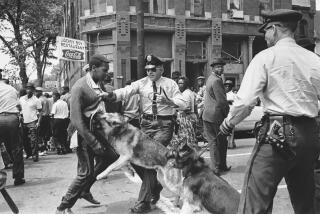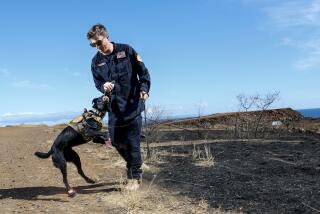Bomb-sniffing dogs are soldiers’ best friends
Reporting from Kuhak, Afghanistan — The military considers them just another piece of equipment; they even have service numbers tattooed inside their ears.
Soldiers often treat them as pets, playing with them and feeding them the junk food common on the remote bases of Afghanistan.
To their handlers, bomb-sniffing dogs are more like battle buddies.
“I’d trust Urmel over most people,” Army Sgt. Tait Terzo said of his 4-year-old Belgian Malinois (service number: L-424).
At the same time, he said, if a bomb is lethal, better it kills a dog than a human.
“I hate to say it, but I’d rather lose a dog than a person, as much as it would hurt to lose Urmel,” Terzo said.
For the last year, military working dogs — Belgian Malinois, German shepherds and Labradors — have been joining patrols in southern Afghanistan. Their handlers say the dogs have detected homemade bombs, explosives, bomb-making factories, weapons and ammunition stockpiles.
The dogs are often the first line of defense for ground troops. Homemade roadside bombs, known as improvised explosive devices, are the leading killer of U.S. forces here, accounting for 56% of combat deaths this year.
A few soldiers are skeptical about how well the dogs detect expertly hidden bombs, but most say they feel safer when the animals lead foot patrols.
“These dogs are saving lives,” said U.S. Air Force Master Sgt. Jerry Wood, program manager for the working dog kennel at Kandahar air field, where no dogs or handlers have been killed despite the ubiquitous roadside bombs in southern Afghanistan. “Every bomb they find is one that won’t kill coalition forces.”
Urmel has sniffed out at least 20 bombs or explosive caches over the last year. Ted, a 6-year-old chocolate Lab, has detected nearly 2,000 pounds of explosives.
On June 5, Urmel and Terzo survived their first explosion when a roadside bomb detonated just after they passed by, slamming them to the ground but causing no serious injuries. The bomb, hidden next to cow manure near a pomegranate orchard west of Kandahar, was planted too far off the dirt path for Urmel to detect it, Terzo said.
In November, Ted and his handler, Army Spc. Robert Sylvia, were near a homemade bomb in Kandahar city when it exploded. Ted wasn’t hurt, but Sylvia sustained a concussion.
In June, Ted sniffed out 30 pounds of homemade explosives hidden in a haystack in the Arghandab Valley, enough to make several bombs.
“Yeah, that’s right; he found the needle in the haystack,” Sylvia said.
Most of the animals are also trained attack dogs.
“We call ‘em land sharks,” Wood said. “They’re mean, lean fighting machines.”
Vincent, a disagreeable Belgian Malinois, has bitten several handlers. He recently bit Army Sgt. Justin McGee, on the thigh, drawing blood.
“Got too close to him, I guess,” McGee said.
“Or maybe that dog is just racist,” he joked. McGee is African-American.
McGee was already nursing a sore shoulder, injured recently when a homemade bomb exploded while he and his dog were on patrol.
Almost every handler has been bitten more than once, usually in training. Dogs and handlers train together for several months before deploying in Afghanistan, where they train almost daily when they’re not on patrol.
The dogs are bought as puppies from breeders worldwide. For the last seven years, dogs have also come from a U.S. military breeding program at Lackland Air Force Base in Texas.
The dogs are taught to sit when they detect explosives so they don’t start digging for buried bombs. They work for rewards: a chew toy or snack in training, though never on patrol.
“Ultimately, they’re working for praise from their handler,” Wood said. “That’s what really drives them.”
Terzel and Urmel have been together fore three years. They flew to Afghanistan on a commercial plane: Urmel in his own seat, fussed over by the cabin crew, who served him ice chips.
Belgian Malinois make the best working dogs, the handlers say. They are leaner and more robust than the second-best breed, German shepherds.
“The Malinois have very high drive and energy,” Terzel said.
Most dogs work until they are 8 to 10, though one 14-year-old is still working. On the other hand, one 4-year-old had to be “decertified,” or retired.
“Too much exposure to too many bad things,” Wood said.
The dogs are watched closely for signs of stress or fear when they return to the kennel from patrols. Handlers and veterinarians watch for a sudden change in behavior and try to determine the cause, such as separation anxiety when a handler goes on leave, or adverse reactions to an explosion. (The military is conducting studies on possible post-traumatic stress syndrome in working dogs, Wood said).
Urmel handled his first bomb explosion well, Terzel said. He’s been exposed to many controlled detonations; on a recent patrol, Urmel winced each time an explosives specialist screamed out “Fire in the hole!” to announce a detonation.
“He knows that phrase pretty well,” Terzel said.
Urmel, the only kennel dog allowed to wander the handlers’ working area beyond the locked cages, follows Terzo’s every move, seeking his approval while accepting belly rubs from any available human.
But during attack training on the Kandahar base, Urmel becomes a snarling, lunging whirl.
As part of an exercise, Spc. Marcus Bernardy put on a thick, padded coat and played the role of a fleeing suspect. Terzo released Urmel, who speeded after Bernardy, leaped to sink his teeth into a padded arm, and slammed the 205-pound soldier to the ground.
Growling and clenching, Urmel hung fast until Terzo ordered him to release.
In a second exercise, Urmel again raced after Bernardy. But this time, as the dog was about to leap and strike, Terzo shouted “Out!” Urmel veered past Bernardy, doubled back, and hovered over the suspect, growling and slobbering.
Terzo smiled down at Bernardy, who was on his face in the dirt, sweating profusely.
“Basically,” Terzo said, “he’s a bullet we can call back.”
More to Read
Sign up for Essential California
The most important California stories and recommendations in your inbox every morning.
You may occasionally receive promotional content from the Los Angeles Times.











